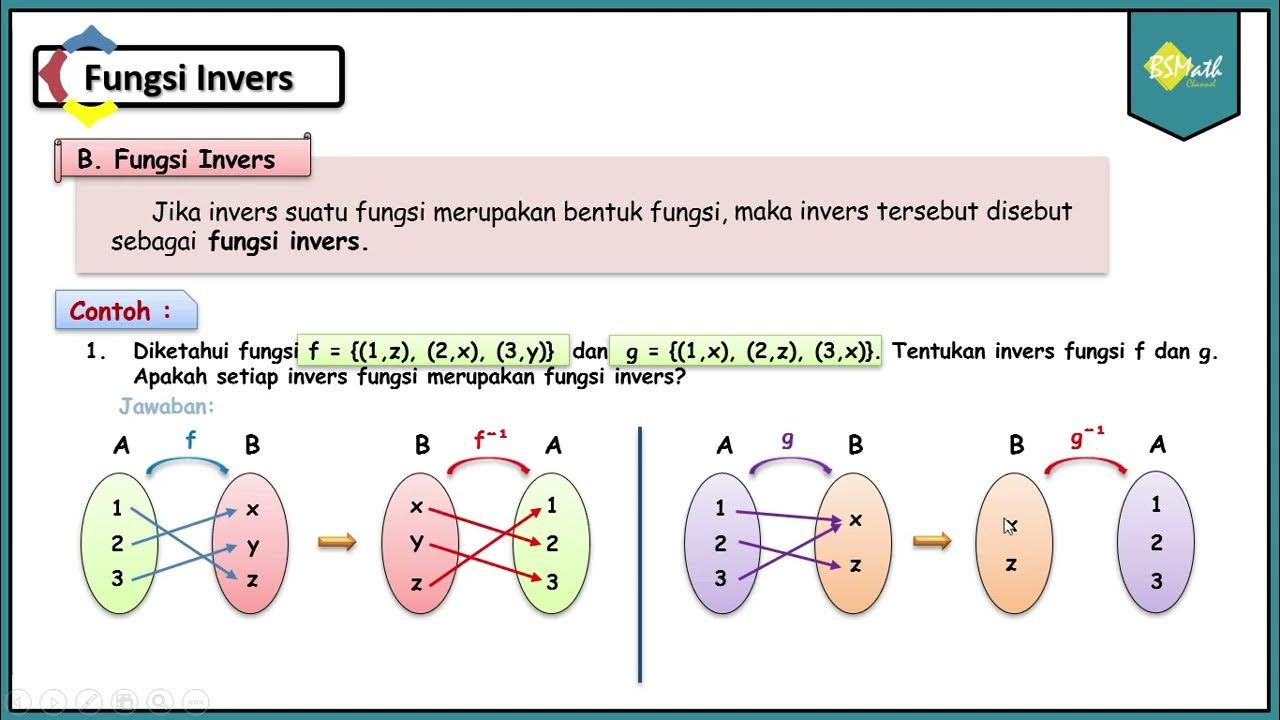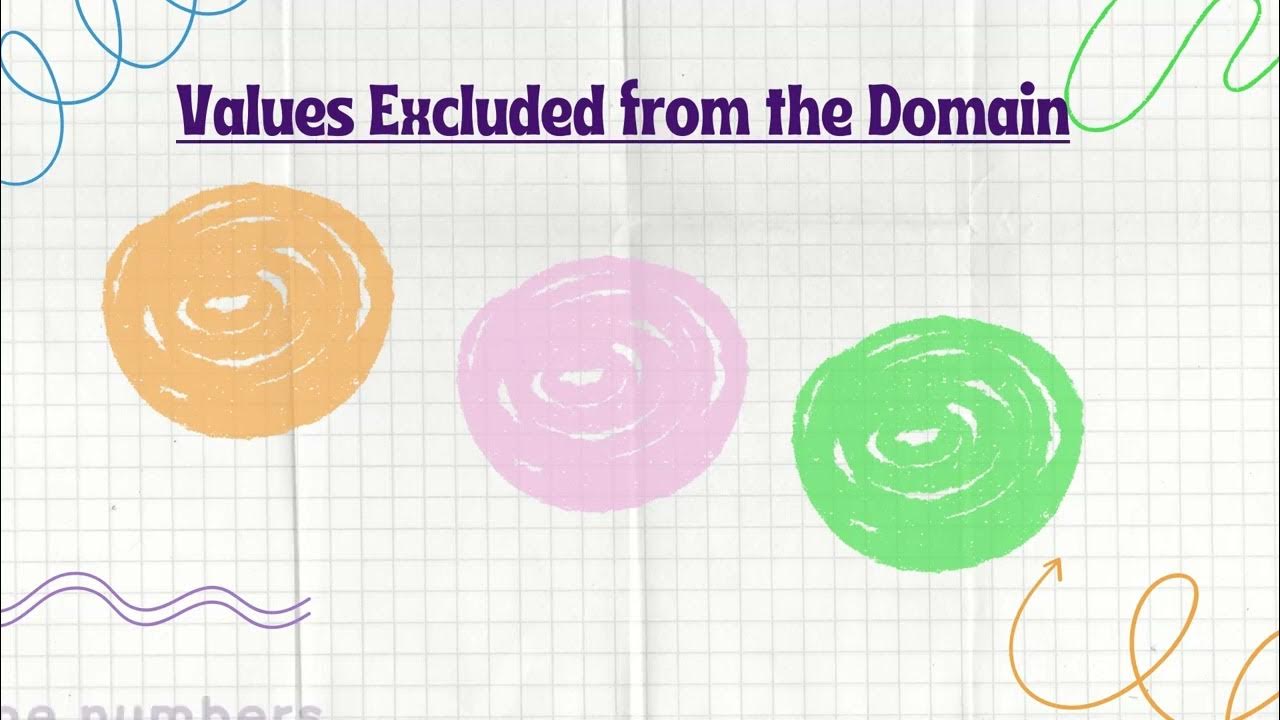Lec 44 - One-to-One Function: Examples & Theorems
Summary
TLDRThis video script explores the concept of one-to-one functions, providing examples to illustrate the concept. It begins by examining the modulus function, demonstrating it is not one-to-one using the horizontal line test. It then contrasts this with the linear function, f(x) = x, which is shown to be one-to-one. The script further delves into cubic functions, proving their one-to-one nature through the same test. The presenter also introduces the theorem that a function is one-to-one if no horizontal line intersects its graph more than once. Finally, the script identifies increasing and decreasing functions as classes of one-to-one functions, concluding with the notion that one-to-one functions are common and reversible, setting the stage for a discussion on exponential functions.
Takeaways
- 📚 The script discusses the concept of one-to-one functions, also known as injective functions, in the context of mathematics.
- 🔍 It uses the modulus function, f(x) = |x|, as an example to demonstrate that it is not a one-to-one function due to the same output for different inputs (e.g., f(2) = f(-2) = 2).
- 📈 The script explains the vertical line test to determine if a relation is a function, ensuring no vertical line intersects the graph more than once.
- 📉 The horizontal line test is introduced as a method to check if a function is one-to-one, where a horizontal line should intersect the graph at most once.
- 👍 The linear function f(x) = x is confirmed to be one-to-one because for any two different inputs x1 and x2, the outputs f(x1) and f(x2) are also different.
- 📊 The script suggests that cubic functions, represented graphically with an example, are one-to-one due to their nature of not intersecting with a horizontal line at more than one point.
- 📘 A theorem is presented: if any horizontal line intersects the graph of a function at most once, the function is one-to-one.
- 🔑 The proof of the theorem is outlined, stating that if a function is not one-to-one, a horizontal line will intersect its graph at more than one point.
- 📝 The class of functions that are one-to-one is explored, highlighting that strictly increasing or decreasing functions are one-to-one based on the horizontal line test.
- 📉 The script provides intuition for why increasing and decreasing functions are one-to-one, as they satisfy the condition that for any x1 < x2, f(x1) < f(x2) for increasing functions and f(x1) > f(x2) for decreasing functions.
- 🌐 The script concludes by emphasizing that one-to-one functions are common and can be reversible, setting the stage for further topics such as exponential functions.
Q & A
What is a one-to-one function?
-A one-to-one function, also known as an injective function, is a function where each input is mapped to a unique output, meaning no two different inputs will have the same output.
How can you determine if the function f(x) = |x| is one-to-one?
-You can determine if the function f(x) = |x| is one-to-one by using the horizontal line test. If no horizontal line intersects the graph of the function at more than one point, then the function is one-to-one. In the case of f(x) = |x|, it is not one-to-one because, for example, f(2) = f(-2) = 2.
What is the vertical line test, and how does it apply to the function f(x) = x?
-The vertical line test is a graphical method to determine if a curve is the graph of a function. If every vertical line intersects the curve at most once, then it passes the vertical line test and is a valid function. For f(x) = x, the vertical line test is passed because each vertical line intersects the line y = x at exactly one point.
Why is the function f(x) = x considered one-to-one?
-The function f(x) = x is one-to-one because for any two different inputs x1 and x2, the outputs will also be different (f(x1) = x1 and f(x2) = x2), meaning x1 ≠ x2 implies f(x1) ≠ f(x2).
What is the horizontal line test, and how does it relate to one-to-one functions?
-The horizontal line test involves drawing horizontal lines across the graph of a function and checking if any line intersects the graph at more than one point. If no horizontal line intersects the graph more than once, the function is one-to-one.
Can cubic functions be one-to-one? If so, under what conditions?
-Cubic functions can be one-to-one depending on their specific form and coefficients. A cubic function is one-to-one if it is strictly increasing or strictly decreasing, meaning that as x increases, f(x) also increases or decreases without any reversals.
What is the theorem stated in the script regarding the horizontal line test and one-to-one functions?
-The theorem states that if any horizontal line intersects the graph of a function at most in one point, then the function is one-to-one.
How can you prove that if a function is not one-to-one, it will intersect some horizontal line at more than one point?
-If a function is not one-to-one, there exist at least two different inputs x1 and x2 that yield the same output (f(x1) = f(x2)). By plotting these points on the graph and drawing a horizontal line at the level of the common output, this line will intersect the graph at both points (x1, f(x1)) and (x2, f(x2)), demonstrating the function is not one-to-one.
What class of functions are generally one-to-one?
-Increasing functions and decreasing functions are generally one-to-one. An increasing function is one where if x1 < x2, then f(x1) ≤ f(x2), and a decreasing function is one where if x1 < x2, then f(x1) ≥ f(x2).
Why are one-to-one functions considered abundant in nature and reversible?
-One-to-one functions are abundant because they represent a wide variety of mathematical relationships where each input corresponds to a unique output. They are reversible because knowing the output allows you to uniquely determine the input, which is a desirable property in many mathematical and real-world applications.
What is the next topic discussed in the script after one-to-one functions?
-The next topic discussed in the script is exponential functions.
Outlines

هذا القسم متوفر فقط للمشتركين. يرجى الترقية للوصول إلى هذه الميزة.
قم بالترقية الآنMindmap

هذا القسم متوفر فقط للمشتركين. يرجى الترقية للوصول إلى هذه الميزة.
قم بالترقية الآنKeywords

هذا القسم متوفر فقط للمشتركين. يرجى الترقية للوصول إلى هذه الميزة.
قم بالترقية الآنHighlights

هذا القسم متوفر فقط للمشتركين. يرجى الترقية للوصول إلى هذه الميزة.
قم بالترقية الآنTranscripts

هذا القسم متوفر فقط للمشتركين. يرجى الترقية للوصول إلى هذه الميزة.
قم بالترقية الآنتصفح المزيد من مقاطع الفيديو ذات الصلة

Fungsi Invers - Matematika SMA Kelas XI Kurikulum Merdeka

Kalkulus 1: Fungsi dan Grafik Fungsi

Functions

What is 3D Translation Explained in Hindi l Computer Graphics

INVERSE OF ONE-TO-ONE FUNCTIONS || GRADE 11 GENERAL MATHEMATICS Q1

Verifying inverse functions by composition | Mathematics III | High School Math | Khan Academy
5.0 / 5 (0 votes)
